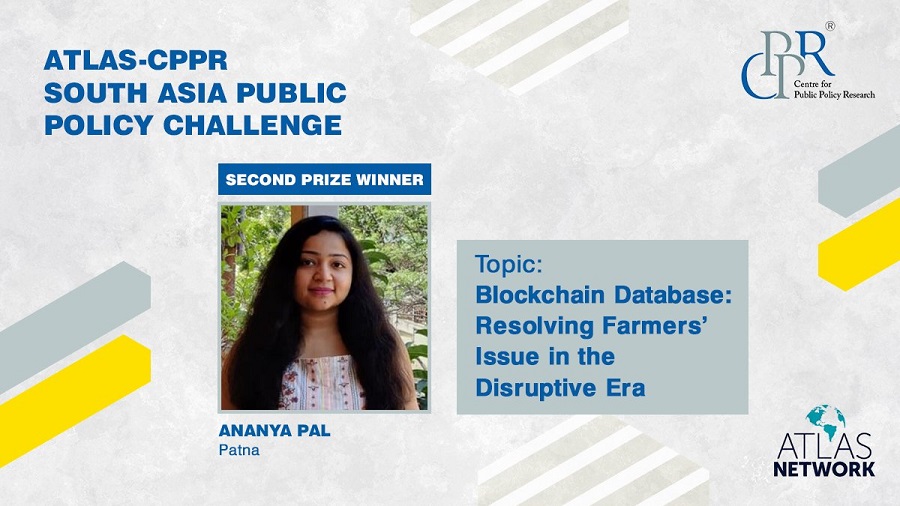

By Ananya Pal
From peaceful condemnation and indefinite meetings to media outrages and political vendetta, the global synergies along with Indian farmers have willingly forsaken amendments for rejection. The lack of countenance for resolution over the three farm laws only harps on the failure of public policy making. Supplementing this, resolving consequent national crises and making India a $5 trillion economy, are tasks that beseech formulation of a dynamically disruptive policy – thus, introducing Blockchain technology.
The issues provoking the protest stem from the apprehension surrounding contract farming. The Farmers Agreement on Price Assurance and Farm Services Act, 2020 threatens the existence of APMCs by deregularising private trade, replaces MSP with a vague ‘guaranteed price’ and excludes civil court in the three-level dispute settlement mechanism.
The Farmers’ Produce Trade and Commerce Act, 2020 prohibits the State governments from levying any market fee/cess on trade happening outside APMC areas. It will prove unfair to APMC traders who pay for license and 1% fee on their transactions. The Essential Commodities (Amendment) Act, 2020 dictates imposition of stock limits by the government on rare occasions. This gives big companies the freedom to stock commodities and make farmers the price-takers.
Underlying these problems is the question of eroding trust of farmers, which demands a solution based on Blockchain Technology. Blockchain is essentially a digital ledger of transactions that is duplicated and distributed across the entire network of computer systems, making it almost impossible to change, hack or cheat the system. The Blockchain database will store and implement the farm-contract on its own, without requiring the parties to sustain mutual trust. Once the parties to the contract – the farmer and the institutional buyer – sign a legal contract, they will upload the implementation part of the contract onto the database.
Thereafter, this digitised part of the contract called ‘smart-contract’ will execute itself as and when the predetermined conditions are met. For example, a smart-contract between a farmer and a company-A comes into force. Company-A buys 1000 seeds from the seed company at Rs.10,000 and provides exactly 1000 seeds to the farmer. The seed company, company-A and the farmer will get notified to testify sequentially. This will make supply-chain management transparent. To make it faster and cost effective, RFID e-seal tags will be used to seal and store the produce in bags.
On the delivery day, when the company scans the tags, the system will inspect tamper-evidence, GPS-tracking records etc. and automatically initiate payment to the farmer accordingly. If the payment fails, the produce will be refused and the contract will reach a hiatus. It favours the companies by keeping the farmers’ produce in check with smart-contract specified parameters using technologies like Machine Vision Systems.
To access and operate this database, registration of all parties involved will be required on a mobile App, through their PAN/Aadhaar number. These numbers will generate respective encrypted-IDs which will be used to identify them on the database. It will also contain a ‘private-key’ which will generate new digital-signatures each time they sign a smart-contract.
Although the Indian Contract Act, 1872 makes smart-contract legal, it declares self-generated digital signatures as uncertified, making smart-contracts invalid. However, it leaves enough scope to use them as vehicles to effectuate certain provisions of a traditional contract. Thus, a new section 5.1.9 in the National Policy of Farmers, 2007 will have to be created, legalising these ancillary contracts. It will also contain clear provisions regarding individual authorisati for viewing depersonalised data to government agencies, so that they track hoarding of produce by big companies, perform data analysis to decide on MSP, levy fee for
registration (to level with the APMC traders), allow for its admission as evidence in legal dispute etc.
PwC’s ‘Time for Trust’ report (2020), estimates Blockchain’s overall contribution to the Indian economy to surge to $62.2 billion in 2030. The Blockchain database will prove to be the first step towards these estimations, which will thus require seamless internet for farmers, Blockchain training for human resource and a division in the Ministry of Electronics and Information Technology. The Blockchain database has the potential to remove politicisation, enhance corporate governance and provide faster public service delivery, by exercising minimum government-maximum governance.
This article was written by Ananya Pal. Ananya Pal secured second prize at the ATLAS-CPPR South Asia Public Policy challenge 2020-21.
more recommended stories
By Dr. Joseph Sunny Kunnacherry –.
by Dr. Shiva Murarka Sr. Scientist,.
By: Dr. Sreekanth M P, Consultant.
By Dr. Sidharth J Unnithan, Consultant.
By Mayuri Ashish Chaudhari, Senior Physiotherapist.
By Dr Parthasarathy BConsultant Centre of.
Dr. Kumar MuthukumarSenior Consultant,Department of Interventional.
By Dr. Zareena A Khalid,Senior Consultant.
Dr. Roy P. John,Senior Consultant &.
ByDr. Ferdinant JConsultantSurgical EndocrinologistApollo Adlux Hospital,.